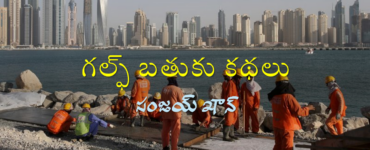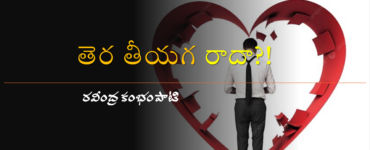The novel, as a formal literary genre, came into being only with the advent of British in India, even though story telling has always been a part of India’s cultural and intellectual psyche. Indian writers in various vernaculars experimented with this form. Even when, in pre-independence period, they wrote novels in line with English literary traditions, the influence of epic story telling persisted and resulted in novels such as Malapalli, which reminds us of our ancient traditions, especially in the context of size, magnitude and the style of narration. It is a novel of about one thousand pages (divided into two volumes), covering two generations and encompassing India’s political, social and cultural life during a particularly turbulent time in the history of the making of the Indian nation.
There are at least three reasons as to why we should revisit this novel now, even though it first published in 1922. The first one is a very personal reason; that of a student walking into my office in IIT Delhi, with a request that he be allowed to do a minor project on any novel in Telugu based on social issues. We do not normally get to interact with students who are interested in literature as they are students of Engineering, who have their priorities elsewhere. This student claimed that he was particularly interested in social issues. I really thought for a while and decided to ask him to read Unnava’s Malapalli, a novel of pre-independence India. The student, as expected, did not come back once he discovered the length of the novel. To add to his problems, it was also written in early twentieth century prose, which is rather challenging to read now. I was disappointed; nevertheless, my interest and curiosity were aroused.
The second reason was more relevant in the context of the reservation debates that are taking place in various forums today after the OBC reservations were declared.
Unnava Lakshminarayana, the author of Malapalli, was a very committed social reformer and an activist of pre-independence India, and along with actively participating in the freedom movement led by Mahatma Gandhi, he was also deeply inspired by the two predominant Gandhian ideals of the time: eradication of untouchability and empowerment of women. He ran an institute called Sarada Niketan, focussing on the organisation of widow remarriages and education of women. This novel assumes a contemporary relevance as it projects a society ridden with the double burden of political oppression by the British as well as exploitation by the landed gentry who were mainly upper caste Hindus, who were used by the political powers for their own gains. It also narrates the story of how the protagonist and his community try to overcome these oppressions by working to educate themselves through various self-help activities.
The third reason was the publication of a translation by Sahitya Academy of Malapalli by Dr. VVB Rama Rao, a well-known writer and translator in Telugu. Though rather late, to bring out a translation of this classic Telugu novel into English, one should say is a good service to the cause of vernacular Indian literatures. The translation is an abridged version of the one thousand-page original novel. I read the translation and it made me go back to the original and read it again. It makes a good read and those who are not familiar with the original can easily relate to the spirit of the novel and wonder at the ease and at the same time skill with which the translator managed to translate Unnava’s commitment to the issues of contemporary relevance like oppression of the socially backward by the caste Hindus, the nexus they had enjoyed with the British bureaucracy and how their self-serving interests were met by this nexus; the corrupt executive and judiciary which always helped to facilitate these interests; the inadequate legal system which never helped the underprivileged in any real sense – all these and many more were very well brought out by the novelist and they reflect well in the translation too. The fact that the novel was proscribed twice and had always become a contentious book is spite of its literary merit was proof enough of the truth of the issues that the author tried to raise in this novel. Not only that, the novel also highlights how they adopted the Gandhian model of resistance and through their suffering how they tried to touch the conscience of the nation.
Malapalli, as the title itself indicates, is the story of a colony of Malas, a backward tribe, also known as Adi-Andhras. This colony is segregated from the rest of the village and the people of this colony were not supposed to go into the village without announcing their approach. The Gandhian idea of calling these underprivileged class harijans and developing new colonies for them did not actually integrate them with the rest of the society but had actually caused a wider rift as more such “malapallis” emerged all over the country where the harijans were forced to live outside the town or village. They were prevented access to the schools, temples and the village wells even. But the senior leaders of this colony in this novel adopt the ideal of Gandhian of resistance in a non-violent mode and try to improve their lot by opting to organise schools for themselves and to a large extent successfully manage to change the mindset of the second generation feudal landlords into lending a helping hand in the efforts to build their lives.
Here is the story of Malapalli in brief: Though the novel had a subtitle Sanga Vijayam (the victory of Sanga), the chief protagonist of the story was the father Ramadas who plays a major role throughout the novel, whereas Sanga’ role ends almost halfway through the novel. Ramadas had two sons – Venkatadas and Sangadas. He also had a daughter named Jyoti who was sent to a village teacher for basic education and later to the town nearby for higher studies. She eventually becomes a teacher and dedicates her life to teaching the children of her colony. Sangadas works in the household of Chodharayya, an upper caste Hindu landlord. His house and land was located in a small village called Mangalapuram in the Guntur district of Andhra region. Choudharayya is a landlord of a considerable spread and a close associate of the powers that represented the British political administration in the village. His son Rama Naidu moves closely with Sanga and together they organise the village labour and help them to extract higher wages for the labourers of the village from the land lords. Choudharayya comes to know that his son went with Sanga to the Adi Andhra conference where eminent leaders and social reformers set the agenda for the upliftment of the Adi Andhras, a low caste untouchable community of the area. He was so angry with Sanga for ‘polluting’ his son by sitting along with him and eating with him, that he hits him heavily on the head with a rod which results in Sanga’s immediate death. Though the death was accidental and he had hit him in mindless anger the murder charge frightens Choudharayya so much that he distributes money bags to the police officers and local villagers to avoid arrest.
Ramadas shocked by the death of his highly popular and dynamic son becomes very sad. Choudarayya makes sure that all the evidence that can implicate him in the murder was wiped out, and pursues his revenge by grabbing the small plot of land that Ramadas had in the village and drives him away from his home along with his family which includes his daughter Jyoti and his nephew Appadas whom she deeply loves. His first son leaves home and becomes a robber in the manner of Robinhood, robbing the rich to feed the poor and never killing anyone in the process. He becomes a legend through his adventures. Assuming the name of Tanikella Jaggadu, he becomes notorious all over the region and becomes a terror for the rich and a benefactor for the poor. In the village Ramadas was subjected to harassment and his appeals in the court would not yield any result as he did not even have the money to pay for the legal aid provided by his advocate, though the advocate tries to help him to the extent he can. But judiciary becomes a tool in the hands of the administration and a puppet in the hands of people like Choudharayya. Everything else fails for Ramadas and his supporters. They were imprisoned on false criminal charges and the whole family was shifted to the prisoners’ colony.
The warden of this prisoners’ colony falls in love with Jyoti and he proposes that he would get them all released if he was allowed to marry Jyoti which both father and daughter reject. Jyoti was so harassed, that once chased by him she runs into the forest and jumps into the river. Appadas follows her into the river and gives up his life. During the same time Ramadas’ first son who organises robberies in the name of feeding the poor gets caught and father and son meet in prison. Ramadas gets to know the true identity of Tanikella Jaggadu as that of his son Venkatadas. The seriously injured Jaggadu dies in the prison but before he dies while defending his actions in the court he exposes the corruption of the executive and the judiciary and tells the world how the upper caste Hindus take advantage of their proximity to the administration to deprive the underprivileged classes of the access to justice and that they would not hesitate to harass the families of the victims too.
Choudarayya’s son Ramanaidu feels enraged by his father’s attitude toward Sanga’s family and turns away from his father. His wife leaves him and her infant son to run away with a cousin of his, handsome Mohan. They run away to Madras where she was afflicted with cholera. With difficulty she escapes death and comes back to Choudarayya’s house as her own son’s nanny with a new name Kamalamma. No one could identify her as the disease totally disfigures her face and her earlier beauty. Rama Naidu along with his brother sets up the school and helps the family of Ramadas to build the Sanga Mandiram, a place of worship for Sanga, on the exact spot where Sanga died, a school for the underprivileged where all of them take it upon themselves to teach. The spiritual inclinations of Ramadas in the end help him to overcome all his problems as he becomes the driving force behind all the effort to redeem the Mala caste of the village through education. Though the problems cannot be solved the novel ends on a positive note as the champion of the underprivileged becomes the leader and tries to help others like him to face the menace of discrimination.
The novel is relevant in today’s context as the main focus of the novel in addition to the troubles and travails of a backward caste colony is also to visualize a social situation where the leadership and desire for change emerges from within the underprivileged class. People like Ramadas did not ever think that they needed political power to uplift their fellow caste members. They thought education as the necessary prerequisite for bringing about a social change. In independent India for three generations now, underprivileged classes have been given access to primary, secondary and higher educational institutions constitutionally. However, no study has ever been made to see how many of them have actually contributed to the uplift of their own. It stops at the level of the individual advancement and the instances where some of them have looked back on the communities they left behind in their effort to become upwardly mobile are very few. The efforts have always been on to retain the backward status for political mileage than to come out of it. Even when some of them have gained political power too, their communities have not gained by their success or progress. If at all there is any advantage it is to the children of the privileged underprivileged. This novel in a way foresees this and sets an agenda for progress and the sacrifices that Ramadas and his like made in the novel are not merely fiction- as they have suffered at the hands of the political and caste masters and enough of historical documentation exists to prove this. Even after independence in Chundur and in Karamchedu, we have heard and were outraged by the news of the backward caste youth being set on fire.
The novel effectively highlights the sensitivity and the helplessness of the exploited towards issues of social and economic discriminations aided and abetted by the ruling political powers. It envisages a situation where the voice of protest, feeble though it may be, emerges out of the so called illiterate and though their political awareness does not help them to improve their situation, it evokes sympathy for their plight in the mind of the reader. Malapalli also highlights the visions of a better tomorrow emerging from their own cadres. It portrays with equal adroitness and creative imagination the injustice and the resultant unrest as a breeding ground for the extremist thought raising and ruling the minds of the oppressed, which in due course of time becomes the cancer that eats the system from within. All the states in India which have now become victims of radical revolutionary politics are in fact the consequence of the actions or rather inactions of the established political powers and their apathy towards solving their genuine grievances. The writers then and now have effectively portrayed these issues in creative fiction and that their warnings have not been heeded is there for all to see now. If fictions are records of what happened in history, fictions also are prophetic voices signalling the future maladies.
*









Add comment